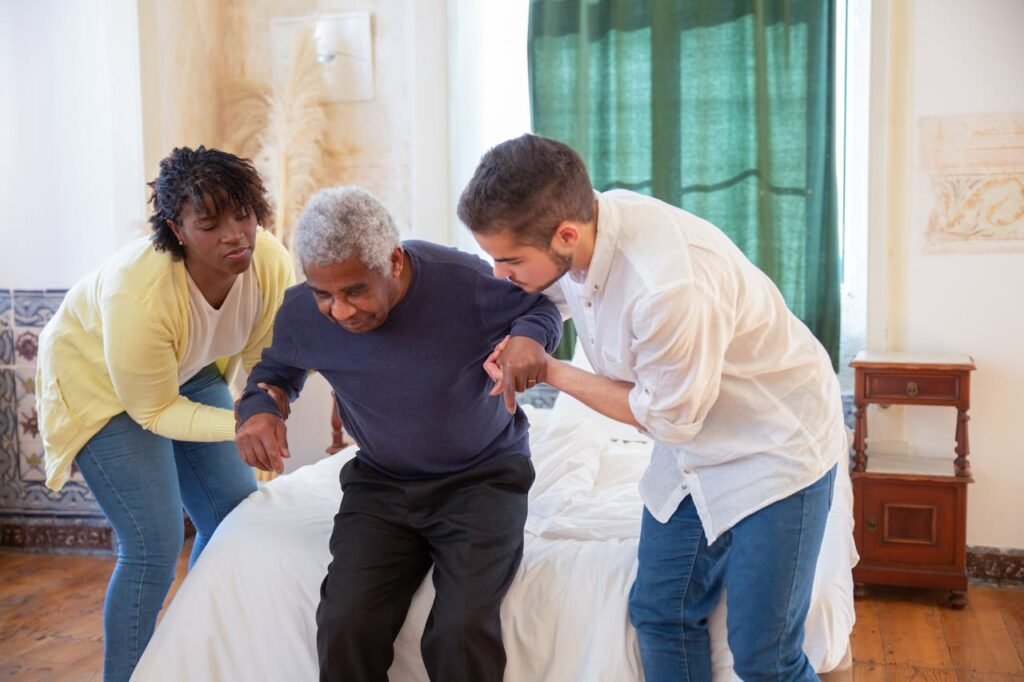Caring for a senior who uses a prosthetic limb is a journey of patience, compassion, and daily teamwork. It’s not just about helping them walk or move—it’s about restoring their comfort, confidence, and independence every single day. For many caregivers, the task may feel delicate at first. You might wonder how to help without overstepping or how to keep the prosthesis in perfect condition.
The truth is, caring for a prosthetic user doesn’t have to be complicated. With the right knowledge and small daily habits, you can make life smoother, safer, and more enjoyable for both you and your loved one. Every day brings small routines—checking the prosthesis, cleaning the limb, helping with balance, encouraging gentle activity, and keeping spirits high. These routines build trust, strength, and stability over time.
At RoboBionics, we’ve met hundreds of families who support seniors using prosthetics. We’ve seen how a little care, given with consistency, helps them live freely again. This detailed guide is for caregivers—sons, daughters, spouses, or professionals—who want to offer the best possible daily care for senior prosthetic users.
You’ll find here a full day’s guide—morning to night—on what to check, how to assist, and how to encourage both physical comfort and emotional wellbeing. Each step is practical, simple, and tested in real homes.
Morning Care Routine: Comfort, Cleanliness, and Confidence
Starting the Day with Gentle Check-ins
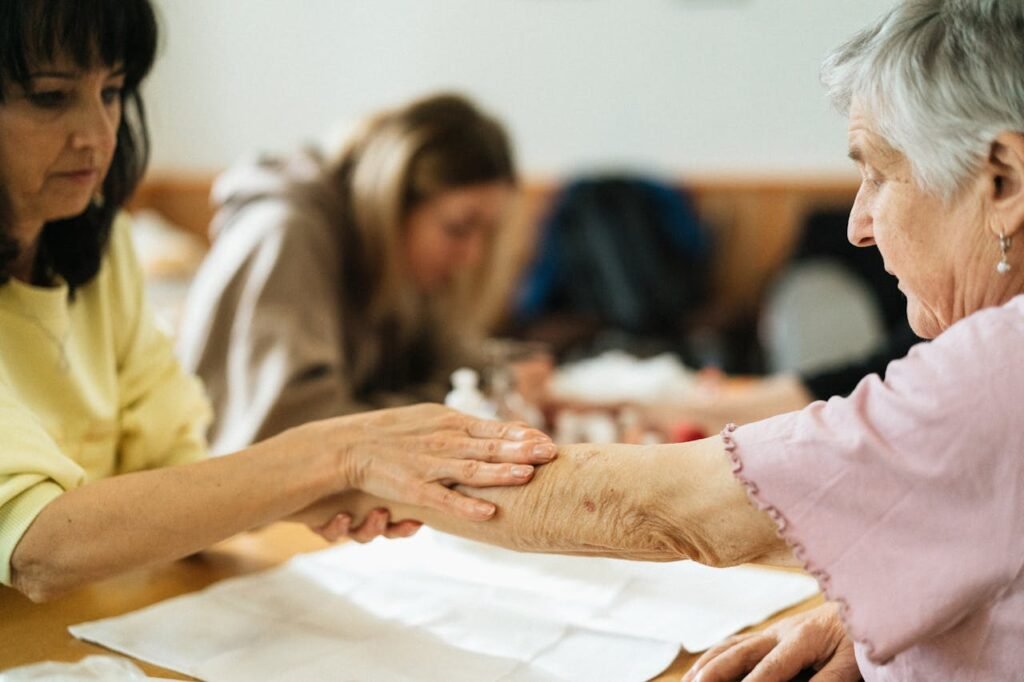
The morning sets the tone for the whole day. Begin each day by greeting your loved one with warmth and calm. Ask how they slept and whether they feel any soreness or stiffness. Seniors using prosthetics often experience mild swelling or tightness in the residual limb after waking up, especially if the weather is humid or cold.
Give them a few minutes to stretch or sit comfortably before putting on the prosthesis. Encourage slow, deep breathing—it helps with circulation and eases tension. This quiet moment also helps you notice if something feels different from the previous day.
If they seem tired or hesitant, reassure them that there’s no rush. Patience builds confidence, and calm mornings help the rest of the day flow more smoothly.
Checking the Residual Limb
Before fitting the prosthesis, always check the skin on the residual limb. Look for any redness, swelling, dry patches, or blisters. Even small skin irritations can worsen if ignored.
Use a soft, clean cloth to gently wipe the limb with lukewarm water. Avoid hot water or harsh soaps—they can irritate the skin. Pat dry with a towel instead of rubbing. Clean, dry skin prevents infection and ensures a snug, comfortable fit.
If you notice any redness that doesn’t fade after a few minutes, give the limb a short rest before fitting the prosthesis. Persistent irritation may need a quick review by a prosthetist.
Inspecting and Cleaning the Prosthesis
While your loved one freshens up, take a moment to inspect the prosthetic limb. Look closely at the socket, straps, and moving parts. Make sure there’s no dust, moisture, or loose fittings. If it’s a bionic or electronic model, check the battery level and charge it if needed.
Clean the inner socket gently with a damp cloth. For silicone liners, use mild soap and water, then dry them thoroughly before use. A clean prosthesis prevents odors, friction, and discomfort.
Regular inspection also helps catch small issues before they turn into big repairs. For seniors, comfort depends as much on the prosthesis’ condition as on their physical health.
Helping with the Fit
Once the limb and socket are clean and dry, help your loved one put on the prosthesis slowly. Make sure liners and socks are correctly positioned—no wrinkles or folds. These can cause pressure points during movement.
Encourage them to do this themselves if possible. Independence is empowering. You can stay close to provide light support or balance while they adjust straps or align the limb.
If it’s a myoelectric prosthesis, like RoboBionics’ Grippy™, confirm that the sensors are clean and responsive. The connection between the limb and the prosthesis should feel natural, not forced.
Ensuring Balance and Comfort
Once fitted, help your loved one stand up gently. Let them take a few steps in place while you observe their balance. Ask if the prosthesis feels even or if there’s any pinching.
Encourage slow walking across a short distance. If the limb feels too tight or too loose, remove it and refit. Comfort is key—it’s better to take a few extra minutes adjusting than risk irritation later.
As they move, watch for posture. Shoulders should be relaxed, and the body should feel centered. These small details make a big difference in how easily they move through the day.
Morning Hygiene and Dressing
After fitting the prosthesis, move to personal grooming. Keep everything close to avoid unnecessary bending or reaching. A sturdy chair or stool in the bathroom helps during washing or shaving.
Encourage clothing that’s easy to wear and breathable. Avoid tight cuffs or waistbands that may interfere with prosthetic movement. For leg prosthetic users, longer socks or soft liners prevent rubbing against clothing seams.
Shoes should fit well and have good grip. Slip-resistant soles and secure straps are safer than laces that can loosen. Seniors should always wear both shoes, even when using one prosthetic leg, to maintain even balance.
Supporting Breakfast and Medication
Once grooming is done, help set up a calm breakfast environment. Sitting comfortably with both feet supported on the ground helps posture and digestion.
Serve foods rich in protein and fiber—they support muscle health and energy levels. Hydration is also important, so encourage water or light herbal tea.
If medications are part of their morning routine, double-check doses and timing. Consistency matters, especially for circulation and joint health. You can keep a small notebook to record medications, meals, and energy levels. Over time, this record helps track how diet and prosthetic use affect daily comfort.
Encouraging Gentle Morning Activity
After breakfast, light activity prepares the body for the day. A few stretches or short walks around the house can loosen stiff muscles and build confidence.
Encourage slow movements—raising arms, rolling shoulders, or marching in place. If your loved one is new to using a prosthesis, let them rest between exercises. The goal is comfort, not strain.
If your home allows, step outside for a few minutes of sunlight. Morning light boosts mood and helps regulate sleep. It’s also a beautiful way to start the day with positivity and connection.
Emotional Check-in
Physical care matters, but emotional well-being matters just as much. Ask how they’re feeling—hopeful, tired, or maybe unsure. Listen gently and without rushing.
Remind them of their progress. Celebrate even small wins, like walking from one room to another or completing the morning routine without help.
Kind words and patience make rehabilitation easier. Seniors often need reassurance that they’re doing well, even on days when movement feels slow.
Daytime Care: Mobility, Meals, and Mindful Support
Encouraging Steady Movement Through the Day
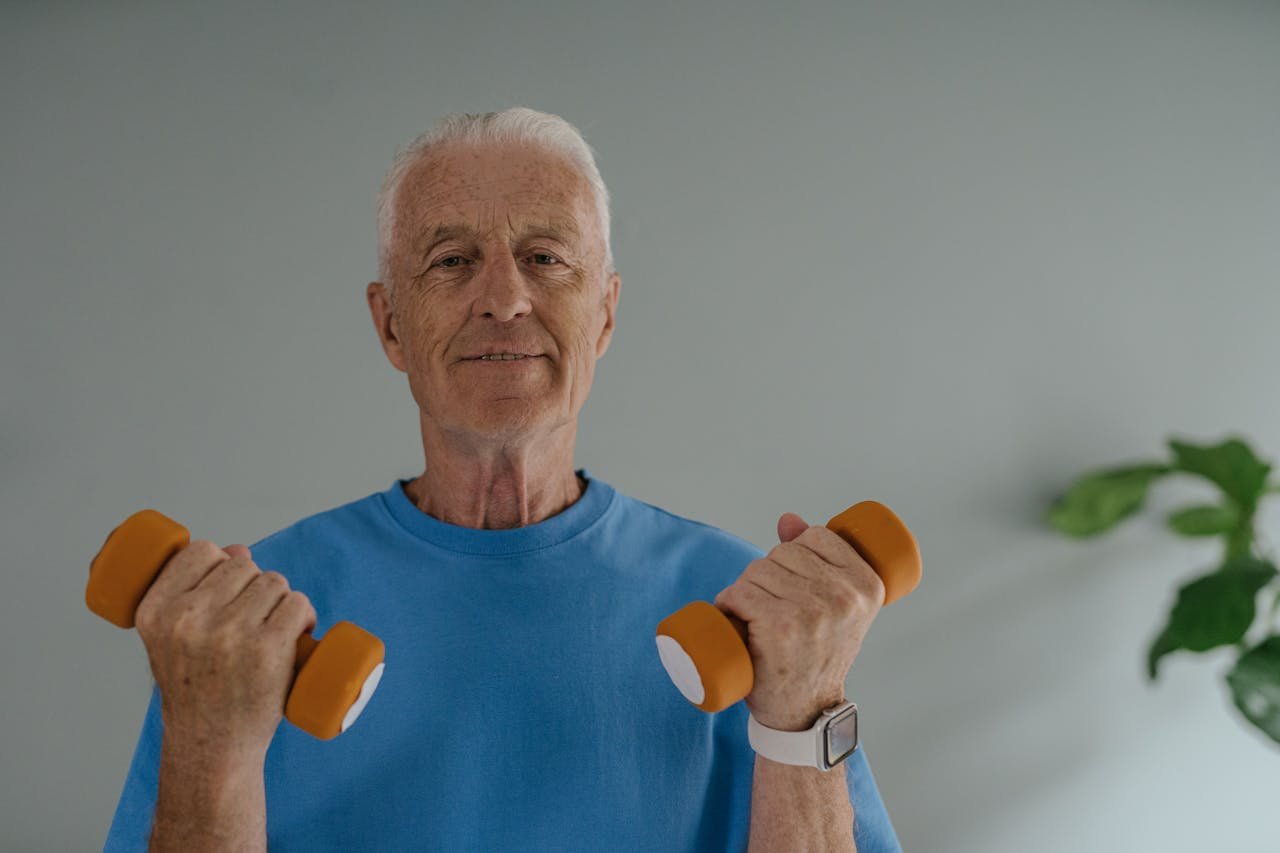
Daytime is when most activity happens—moving between rooms, doing light chores, or simply enjoying time with family. Seniors using prosthetics need gentle reminders to stay active without tiring themselves.
Encourage movement every hour, even if it’s just standing, stretching, or walking a few steps. Long sitting sessions can make joints stiff and slow down circulation, especially around the residual limb.
If your loved one uses a prosthetic leg, help them find balance between rest and activity. Too much movement can cause discomfort, while too little can lead to weakness. The goal is steady, gentle motion.
Walking aids like canes or walkers can offer confidence during transitions, especially for seniors still getting used to their prosthesis. Keep them nearby but encourage reliance on them only as needed.
Checking Comfort and Alignment
As the day goes on, check in occasionally about how the prosthesis feels. Heat, sweat, or swelling can affect the fit. If your loved one mentions discomfort, help them remove the prosthesis for a short break.
Inspect the limb and liner for signs of friction or pressure. Sometimes, a simple adjustment—like changing the sock layer or re-tightening straps—can make a big difference.
Encourage open communication. Many seniors hesitate to admit pain, fearing it shows weakness. Remind them that small issues caught early prevent bigger problems later.
Maintaining the Prosthesis Midday
By midday, the prosthesis may need a quick cleaning or adjustment, especially in warm weather. Use a soft cloth to wipe away moisture and check for any loose parts. For bionic models, confirm that the battery level is still good.
Encourage your loved one to sit comfortably while you inspect. This routine doesn’t just maintain hygiene—it also keeps the prosthesis performing well throughout the day.
If you notice any clicking, stiffness, or unusual sounds, make a note to inform your prosthetist later. Preventive maintenance keeps both safety and comfort intact.
Managing Meals for Energy and Strength
Meals during the day play a huge role in maintaining energy and mood. For seniors using prosthetics, balanced nutrition supports muscle health, skin recovery, and endurance.
Serve meals rich in protein, vitamins, and healthy fats. Fish, lentils, eggs, and leafy greens are excellent choices. Avoid very salty or processed foods that may cause swelling.
Encourage hydration—water, tender coconut, or light soups help regulate temperature and prevent fatigue. A glass of water every hour or two keeps muscles flexible.
If your loved one takes medication with meals, set gentle reminders. Regular timing supports digestion and prevents side effects like dizziness or weakness.
Supporting Safe Movement Around the Home
Safety is a continuous part of daytime care. Ensure walkways are clear of rugs, wires, or low furniture. Good lighting in hallways and bathrooms makes a big difference in confidence.
If your home has stairs, always stay nearby when your loved one uses them. Encourage them to hold the railing and move at their own pace. Never rush them.
For outdoor movement, check that shoes fit well and the prosthetic limb feels balanced. Uneven paths or wet floors can be challenging—assist gently and give them time to find their rhythm.
Midday Rest and Relaxation
After lunch, most seniors benefit from short rest. Encourage them to remove the prosthesis and relax the limb. This prevents sweating and allows the skin to breathe.
Massage the residual limb gently using a mild moisturizer to improve circulation. Avoid strong pressure or scented creams that might irritate the skin.
You can also use this time to clean the prosthesis lightly. Keeping both the limb and the device fresh ensures comfort for the second half of the day.
During rest, let them read, listen to soft music, or simply nap. Calm rest restores energy for the evening routine.
Gentle Afternoon Activity
After a nap or light break, encourage some gentle physical activity again. It could be a slow walk around the house, stretching arms and legs, or doing light household tasks like folding laundry.
For prosthetic hand users, simple grip exercises with soft balls or towels help maintain strength. For leg users, stepping in place or heel raises near a wall improve balance.
These small movements prevent stiffness and help the body feel active without exhaustion. Always stay nearby for reassurance and safety.
Emotional Encouragement During the Day
Physical support is important, but emotional reassurance matters even more. Seniors often have quiet worries—about slipping, tiring out, or being a burden. Simple words like “You’re doing great” or “I’m proud of how steady you are” can mean a lot.
Encourage independence wherever possible. Let them try daily tasks—tying shoes, pouring water, adjusting the prosthesis. Offer help only when needed. This builds their confidence and keeps their mind active.
Some caregivers find it helpful to keep conversations cheerful during the day. Talk about favorite memories, music, or family updates. Staying emotionally connected reduces anxiety and keeps the day light.
Managing Outings and Appointments
If your day includes travel or doctor visits, plan ahead. Ensure the prosthesis is fitted comfortably before leaving. Carry an extra liner, cleaning cloth, and water bottle.
For long waits, encourage small leg or hand movements to keep circulation steady. If the prosthesis starts to feel heavy or tight, remove it briefly while seated.
For prosthetic hands like Grippy™, ensure the battery is charged and pack the charger in case of longer outings. For leg prosthetics, double-check the shoe alignment before leaving home.
Always keep an emergency contact card in your bag with medical details. It’s a small but important precaution.
Checking for Afternoon Fatigue
As the day progresses, watch for signs of fatigue—slower movements, rubbing the limb, or uneven steps. When you see these cues, it’s time for a short rest or gentle massage.
Encourage your loved one to listen to their body. Fatigue doesn’t mean weakness—it’s just the body asking for a pause. A few minutes of rest helps restore energy for the evening.
If swelling seems frequent or pain persists, note it down. These patterns can help doctors adjust the prosthesis or therapy plan later.
Evening Care: Cleaning, Relaxation, and Reflection
Winding Down the Day Calmly
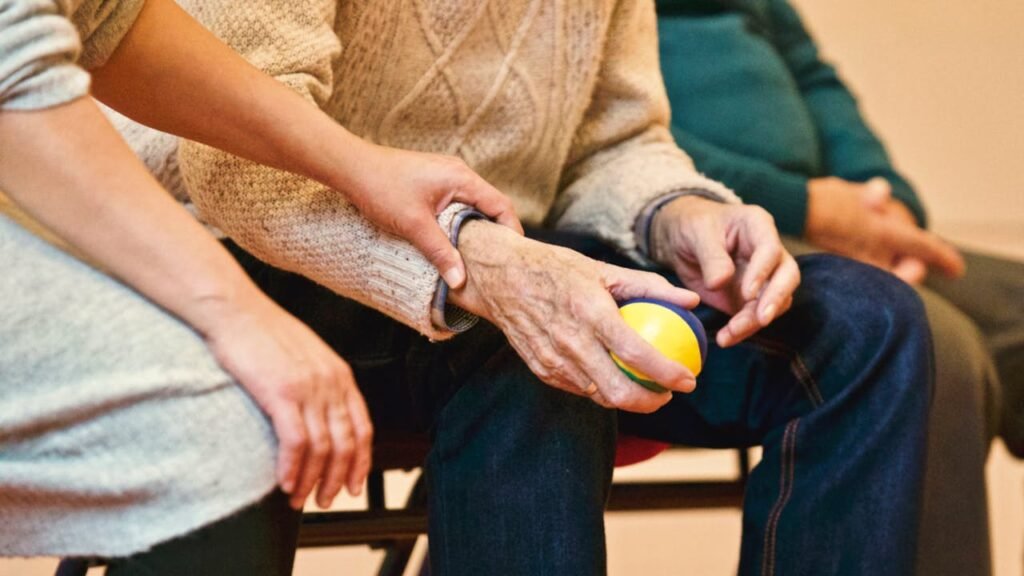
Evening care is about helping your loved one relax after a full day of movement. The body needs time to rest, and so does the prosthetic limb. Create a quiet, calm environment as the day slows down. Dim lights, switch off loud devices, and play soft music if they enjoy it.
Encourage them to sit comfortably before removing the prosthesis. Let this time feel unhurried. The goal is to ease both the body and the mind before bedtime.
You can ask gentle questions about their day—what felt easy, what was tiring, or what they’d like to do differently tomorrow. This helps you understand how their comfort levels change throughout the day.
Removing the Prosthesis Safely
Before taking off the prosthetic limb, ensure your loved one is seated securely. For leg users, support the sound leg on the floor to maintain balance. For arm users, have a soft surface nearby in case they need to rest the limb immediately after removal.
Help loosen straps or release locks slowly. Avoid pulling or twisting, especially if the skin feels tight or warm. If it’s a bionic or myoelectric prosthesis, turn off the power first to save battery and prevent accidental movement.
Once removed, inspect both the prosthesis and the residual limb carefully. Look for any signs of redness, swelling, or soreness. These small checks are crucial—they help prevent irritation and infection.
Cleaning the Limb and Prosthesis
Cleaning at the end of the day keeps everything fresh and safe for the next morning. Use lukewarm water and a mild, fragrance-free soap to wash the residual limb. Gently pat dry with a soft towel instead of rubbing.
Massage a small amount of moisturizer to keep the skin supple, especially around the edges of the socket area. Avoid greasy creams—they can make the liner slippery or attract dust.
Clean the prosthesis with a damp cloth. For silicone liners, wash them with mild soap, rinse thoroughly, and dry them completely before storage. For mechanical parts, wipe off any dust or moisture. If it’s an electronic prosthesis like Grippy™, clean the external surfaces gently and ensure all sensors are free of residue.
Encourage your loved one to treat this process as self-care, not a chore. These few quiet minutes of hygiene often become a comforting ritual.
Inspecting for Signs of Strain or Wear
Evening inspection is a key part of your checklist. It helps you catch small changes that might go unnoticed during the day. Check the limb for new marks or pressure lines. A small red patch might not seem serious, but if it stays overnight, it needs attention.
Examine the socket and joint areas of the prosthesis. Look for loosened straps, worn-out padding, or cracked components. If you hear clicks, squeaks, or feel stiffness when moving it, make a note to contact your prosthetist.
Regular evening checks save your loved one from future discomfort and keep the prosthesis working at its best.
Supporting Gentle Evening Activity
Evenings can be restful yet active in small, meaningful ways. After cleaning and before bed, light stretching or a short walk helps ease the joints and improves sleep.
For leg prosthetic users, simple seated leg lifts or ankle circles work well. For arm users, wrist rotations or shoulder rolls relieve stiffness. Keep movements slow and relaxed—this is about winding down, not exercising hard.
You can also include breathing exercises. Inhale deeply, exhale slowly, and repeat for a few minutes. It calms the body, reduces stress, and promotes relaxation before bedtime.
Preparing for a Comfortable Night
Sleeping comfort is just as important as daytime mobility. Once the prosthesis is removed, help your loved one settle into bed. Place a soft pillow under the residual limb to keep it supported and slightly elevated—this reduces swelling overnight.
Make sure the bed sheets are clean, dry, and wrinkle-free. Rough fabric can irritate sensitive skin. A light blanket works best, keeping them warm without pressure on the limb.
Keep a nightlight nearby for easy visibility if they need to get up during the night. If your loved one uses the restroom frequently, clear the path between the bed and the bathroom to avoid tripping.
Storing the Prosthesis Safely
Proper storage extends the life of the prosthesis. Choose a clean, dry spot away from moisture or direct sunlight. Avoid placing it on the floor where it could collect dust or get knocked over.
For bionic models, unplug chargers once the device is fully powered. Overcharging may shorten battery life. Keep all small accessories, like liners or straps, organized together for easy access the next morning.
If your home has pets or small children, store the prosthesis on a shelf or inside a sturdy cabinet to prevent accidental damage.
Reflecting on the Day’s Progress
Each evening brings a chance to reflect—not just on physical activity, but also emotional progress. Ask gentle questions: Did walking feel easier today? Did the prosthesis feel lighter? Was there any pain or irritation?
Writing these details down can help you notice patterns over time. Maybe a certain shoe causes discomfort, or a specific time of day brings fatigue. Sharing this with your prosthetist can help fine-tune comfort and function.
Reflection also brings gratitude. Remind your loved one of what they accomplished, even if it’s something small. A positive mindset turns recovery into a journey of growth, not struggle.
Encouraging Emotional Well-being
Evenings can be reflective, and sometimes seniors may feel discouraged or tired. Offer gentle reassurance. Remind them that every day they’re improving, even when progress feels slow.
If they seem quiet, invite conversation. Talk about family, memories, or future plans. Emotional support builds resilience. It reminds them that life with a prosthesis is not about limitation—it’s about adaptation and rediscovery.
Laughter helps too. Share a light joke, a short story, or a warm hug. These moments carry more healing than any routine ever could.
Ending the Day with Calm and Care
As bedtime approaches, switch off bright lights and encourage quiet rest. A peaceful night prepares them for a fresh start the next day.
Before leaving the room, check that everything they might need—water, phone, or emergency bell—is within easy reach. Make sure the prosthesis and all accessories are neatly placed and ready for the morning.
Once they’re settled, take a moment for yourself too. Being a caregiver is demanding, and your calm presence matters just as much as your actions. Rest well knowing you’ve helped someone live with comfort, dignity, and hope.
Emotional Support and Communication: The Heart of Daily Care
Building Trust Every Day
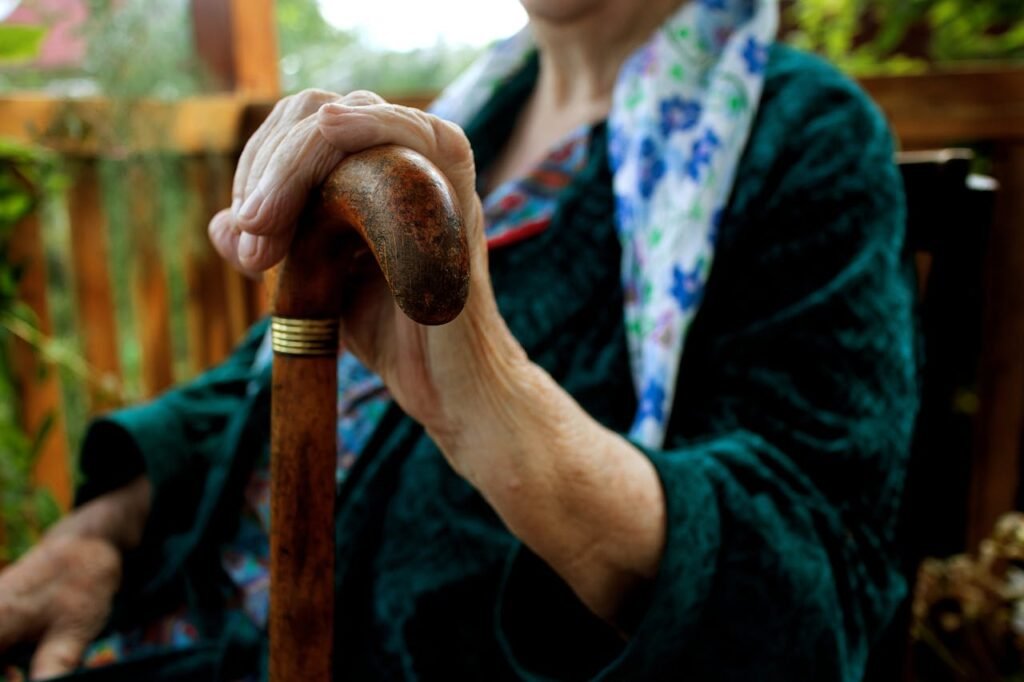
Caring for a senior who uses a prosthetic limb is not only about routines and physical help—it’s about trust. Every small action you take, from cleaning the prosthesis to helping them stand, tells them they are safe and supported.
Trust grows when care feels respectful. Let them make choices whenever possible—what time to do exercises, what to wear, how to spend the day. Independence strengthens dignity, and dignity is essential for emotional health.
Speak gently and clearly. Listen to their worries with patience. Seniors may not always express pain directly—they might just move slower or seem quiet. Your attention helps catch those silent signals early.
Communicating with Care and Respect
Communication shapes every interaction. Instead of giving direct orders, try asking in a warm way: “Would you like to walk now or rest a bit first?” or “Does this feel okay for you?”
These small changes turn caregiving into teamwork. It helps seniors feel heard, not managed. When they sense that their comfort matters, they cooperate more willingly and stay more positive throughout the day.
If frustration ever appears—perhaps during a difficult fitting or a tiring day—stay calm. Take a short pause, breathe, and resume with kindness. Your patience often becomes their strength.
Creating an Encouraging Environment
A positive environment makes daily routines lighter. Keep the home bright, tidy, and full of familiar touches—family photos, soft cushions, soothing colors. Visual comfort reduces anxiety and makes prosthetic use feel normal.
Music also helps. Soft instrumental tunes or favorite old songs can lift mood instantly. Encourage light conversation during meals or activities. When laughter fills the room, the emotional tone of care changes—it becomes companionship, not duty.
You can also set small shared goals: perhaps walking to the garden by the weekend or mastering a simple exercise. Celebrating these milestones adds joy to the process.
Helping Seniors Regain Confidence
Confidence doesn’t return overnight—it’s built in quiet moments of success. Each time your loved one takes a step, uses their prosthetic hand, or completes a task alone, praise them sincerely.
Avoid focusing on what they can’t do. Highlight what they can. Statements like “You moved so smoothly today” or “You handled that perfectly” create a sense of achievement that encourages more effort.
Confidence also comes from familiarity. The more often they use their prosthesis in safe, everyday situations, the more natural it feels. Your steady encouragement bridges the gap between hesitation and trust.
Supporting Emotional Ups and Downs
There will be days when your loved one feels low. Limb loss, even when managed well, can bring emotional waves—sadness, frustration, or self-doubt. These moments need empathy, not solutions.
Sit beside them quietly. Sometimes silence, shared with warmth, says more than words. Let them know it’s okay to feel tired or discouraged. Healing is not a straight road—it curves, pauses, and moves again.
If they struggle with confidence for many days, consider involving a counselor or therapist who specializes in post-amputation recovery. Emotional health strengthens physical progress.
Encouraging Social Interaction
Isolation can make recovery harder. Help your loved one stay socially active, even in small ways. Schedule video calls with family, invite close friends for tea, or accompany them on short outings when they’re ready.
Seeing familiar faces reminds them that life still holds laughter, love, and connection. It also reduces loneliness, a common challenge among seniors.
Community support groups, both online and in person, are also valuable. Meeting others who use prosthetics brings comfort and shared understanding. They exchange tips, stories, and hope—something even the best equipment cannot replace.
Caring for the Caregiver
As a caregiver, your energy fuels the care you give. It’s easy to focus entirely on your loved one and forget your own needs. But your well-being is part of theirs.
Take short breaks during the day. Stretch, walk, breathe fresh air. Eat well and get enough rest. Fatigue can make even simple tasks feel hard. A calm, rested caregiver can handle challenges with more patience and clarity.
Share responsibilities when possible. Ask another family member to help for a few hours so you can recharge. You deserve the same compassion you give.
Remember, caregiving is not about perfection—it’s about presence. Showing up every day with kindness is what makes all the difference.
Fostering a Sense of Purpose
Seniors often find new motivation when they feel useful. Encourage small responsibilities they can handle safely—watering plants, folding laundry, or calling a friend to check in. These activities build confidence and self-worth.
You can also involve them in small family decisions. Ask their opinion on dinner plans or home décor. Inclusion reminds them that they still belong, still matter, and still contribute meaningfully.
A sense of purpose keeps the spirit young. It turns each day from something to endure into something to look forward to.
Creating a Nighttime Routine of Gratitude
Before bed, share a few quiet moments of reflection. Talk about one thing that went well during the day. It could be as simple as “You walked longer today” or “You smiled more this evening.”
This small gratitude ritual ends the day on a peaceful note. It builds optimism and strengthens emotional connection between caregiver and senior.
You can also say a kind word about tomorrow—“We’ll take it easy in the morning” or “Maybe we’ll sit in the garden after breakfast.” Looking forward creates gentle excitement for the next day.
The Power of Compassionate Consistency
Consistency turns care into comfort. Seniors feel safest when their days follow a calm rhythm—regular meals, steady routines, familiar faces. Predictability brings peace.
Even when things go off-schedule, your reassuring tone keeps them anchored. They draw emotional stability from your steady presence. That’s the heart of caregiving—not just assistance, but reassurance.
Your calm, patient approach teaches them that recovery is not something to fear but something to embrace, one day at a time.
Conclusion: The Quiet Strength of Care
Caring for a senior prosthetic user is a balance between hands-on help and heartfelt connection. It’s not about doing everything perfectly—it’s about doing everything with intention and care. Each task you perform, from cleaning the prosthesis to offering a smile, restores independence and dignity.
At RoboBionics, we’ve witnessed countless caregivers transform lives with their steady support. We see how a kind word, a gentle reminder, or a patient pause can change a senior’s entire outlook on recovery. Prosthetics like our Grippy™ Bionic Hand are built to give freedom, but it’s the human touch that turns technology into hope.
Your daily checklist—cleaning, checking, feeding, guiding, listening—isn’t just a series of tasks. It’s a ritual of love. Every day you help someone rediscover confidence, stability, and self-belief.
And remember, you are part of that story too. Your patience is progress. Your encouragement is therapy. Your compassion is strength.
If you or your loved one needs support with prosthetic care, fitting, or rehabilitation guidance, our team at RoboBionics is always here to help. You can schedule a free consultation or demo at www.robobionics.in/bookdemo.
Together, we can make every day safer, smoother, and filled with dignity—for the seniors who inspire us, and for the caregivers who make their journeys possible.



